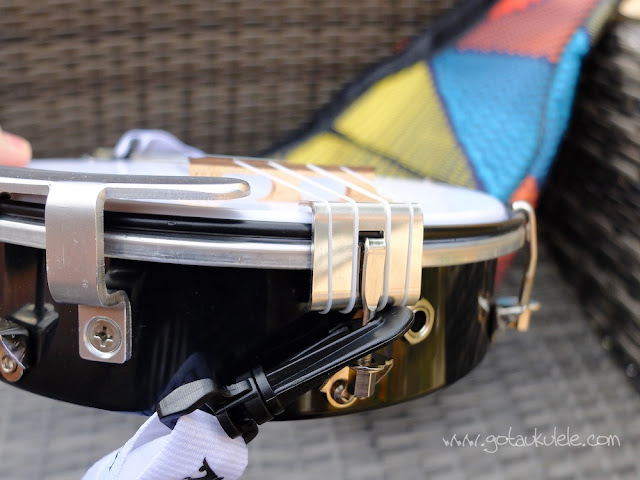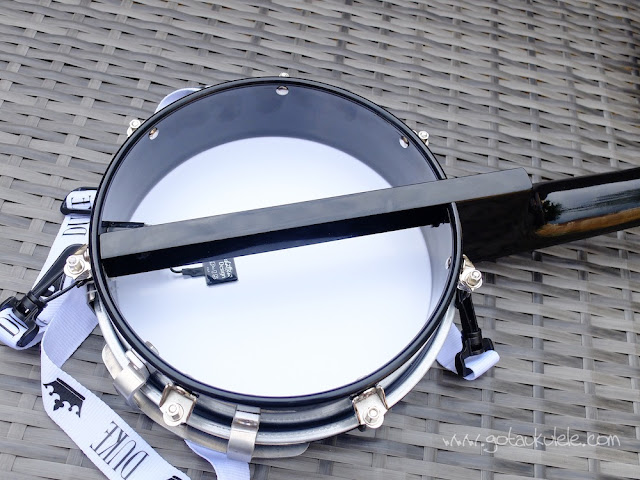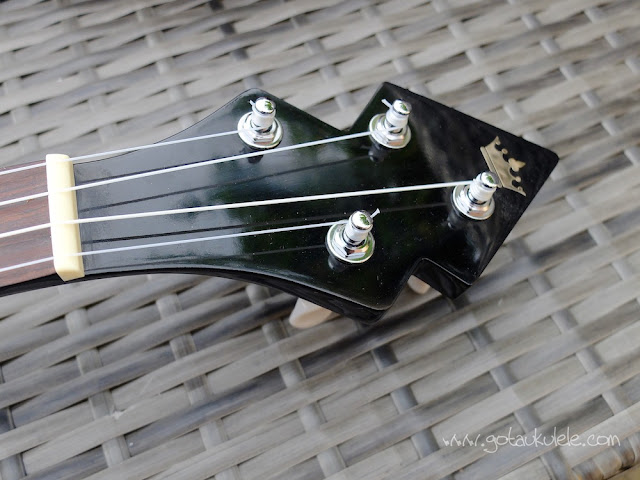Something a bit different on a number of counts for Got A Ukulele reviews this week
Not least because it's the first instrument I have reviewed from New Zealand. Say hello to the DUKE Banjouke!The DUKE is a Banjolele that is the brainchild of Ed Ackman and Lorraine Mecca, all that way away in town called Russell in the northern part of New Zealand. Ed had originally come to be noticed in the ukulele world in developing the Sidekick banjo ukulele, a very light and good value home grown banjolele that proved rather popular. The DUKE represents a replacement to the Sidekick, and whilst it looks every much the same, it comes with a number of updates and improvements. Ed explains that these are made and assembled in New Zealand from parts sourced in USA, China, Canada, New Zealand and Italy. Nice.
Before getting into the meat of the review, it's fair to say that I haven't reviewed all that many banjo ukuleles on the website. One thing is also clear - whenever I do, they do tend to be scrutinised heavily by the traditional banjo ukulele fans out there (ie Formby style fans). And banjo ukuleles that don't meet their exacting standards do tend to receive scorn (such as the Deering and the Fluke Firefly I reviewed). For me though, I consider these things as musical instruments and if they decide to break from the norm in any way, to update the concept or just be a little bit different, then I really admire that. And the DUKE certainly does that for me as you will discover. Each to their own I guess.
The DUKE is a tenor scale banjo uke, which is to say it's a tenor scale neck on an 8" drum head. I personally think it looks proportioned well. A big driver for Ed in developing this one was getting the weight down, and he replaced the wooden tone pot of the Sidekick with a glossy black HDPE (plastic) pot on the DUKE. That meants the total weight of this is now 892 grams, which is certainly super light for a banjo ukulele. And you really do notice that when you hold it.
The head is synthetic and comes with the DUKE logo applied as a sticker. I think it looks bold yet classy. Holding the head in place is an aluminium tone ring held in place with seven drum tensioners. That's fewer than you would normally see on a banjolele, but they do the job and of course are adjustable.
The bridge is a standard looking three footed maple piece and the tail is what they describe as a 'precision smooth edge'. For that, read very plain! But to be fair, plain and simple works on a banjo and there is less to dig into the strings and break them. In fact the strings actually run around the tail and then pass through holes in the pot itself where they are tied off.
Another nice addition that you don't often see on banjo ukes other than as an add on, is the aluminium arm rest fitted to the upper side. These are a godsend on banjos with drum tensioners as they avoid those screws digging into the underside of your forearm when you strum. A welcome addition if a little industrial looking on the finish!
The neck is made from solid mahogany painted gloss black to match the drum. The length of the neck extends beyond the fingerboard and continues as a pole piece across the back of the drum. I couldn't see a way of adjusting the neck for action, so presume an action change would need to be done at the bridge piece itself. We shall see if that is an issue when we get to the setup.
Topping the neck is a rosewood fingerboard, which is nice and even in colour. It's fitted with 18 nickel silver frets that terminate at the top of the drum. They are all nicely finished on the ends. The fingerboard sits flush with the top of the drum head too. The edges of the fingerboard are not bound as such, but the gloss painting on the neck hides the fret edges neatly.
We also have pearloid position markers at the 5th, 7th, 10th and 12th spaces, but sadly no side facing fret markers.
Past the nut (which is made of plastic and 1.4" wide) we have a really interesting shaped asymmetrical headstock that I really rather like. I'm a fan of anything that is different and dares to move away from an easy choice like a three pointed Martin crown. This is certainly different! It's fitted with the Duke crown logo in silver. You will love it or hate it. Personally, I love it!
Flipping it over and we see another upgrade from the Sidekick with the inclusion of planetary geared tuners with silver collars and white buttons. They look great. The benefit of planetary gears is that they have the look of a friction peg (so the ukulele doesn't have ears sticking out!), but use a system of helical gears inside to work like geared pegs. These ones have a 4:1 ratio. They are unbranded and a little different in terms of turning ease, but they work well enough and more importantly, hold the strings just fine.
Completing the deal are quite a few extras worth noting. Firstly is the inclusion of a contact pickup as standard in the form of a Shatten Design LP15 pickup. I must say, most banjo uke players I know would prefer to play into a microphone than plug in and in fact I have had some trouble even finding a pickup that works well for a banjo. Nice therefore to see the inclusion of this, but I suspect many buyers will not be basing their purchase on it (or perhaps using it!).
Also included is a nice padded gig bag complete with Duke logo, a clip on strap with Duke logo, a set of Aquila strings, a felt pick and a spanner for adjusting the drum tension. Seems like they thought of everything really.
As for the price, these are currently in pre-production and on offer for an extremely reasonable $297 with shipping included anywhere in the world. I think that is a stellar price actually. Duke explain that when the initial offer is over, they are likely to be available with a street price of about $440. That is less glamourous as a price, but still fairly reasonable for what you are getting I suppose. I would like to think though that a price between the two could be achieved.
So all in all I think it's a striking looking instrument, with all the features I think you would need, and yet different enough to stand out on it's own.
Taking a closer look at the build and I have no real complaints. The drum is perfectly functional and finished well. The neck is slightly less well finished with one or two thin patches and bubbles in the gloss finish. It's not bad by any sense of the word, but it isn't quite perfect.
To hold, it's incredibly comfortable. The weight is great and is nicely balanced. The arm rest is certainly noticeable and welcome too!
The setup at the nut is perfect on this one, and the first thing I noticed about the setup generally is just how low the action is. Some banjo ukes I have seen have ultra high strings, which personally I don't get on with. I was saying above that I couldn't see a way of lowering the action, and thankfully that isn't an issue as I can't see why you would want to. More importantly, whilst it is low there is no hint of fret buzz. And if you did want to raise the action, that would be as simple as buying a new, taller, saddle piece which are cheap and readily available.
Sound wise - it's very typically 'banjo'. Extremely punchy and strident though extremely easy to play. It's not the loudest banjo I have played, but then that is one of the things that actually puts me off the things! That isn't to say this one is quiet though. It's kind of just right for me.
Strummed, it's extremely satisying, picked a little less so for my ears, although that is more to do with the fact that I don't really pick anything that suits the banjo uke sound. There are some echoes and ghost notes, but that is something I have found with most banjo ukuleles I have played and is simply remedied by rolling up a cloth and wedging it between the head and the pole piece.
Plugged in and the pickup works fine. Like a banjo ukulele but louder (if you wanted such a thing!). It's extremely bright, but adding bass in your EQ on the amp soon remedies that. I suppose I would just prefer a version that was perhaps a touch cheaper if offered without a pickup?
But for me it's all about the style of it, the weight and the ease of playing that I really like. I like things that are bold enough to be a little different. And of course that would be completely pointless if the thing then didn't function as a musical instrument. Thankfully things are good on that score I think, and as such I am happy to give this a Got A Ukulele recommendation! If you are a traditionalist, it may not be for you, but please remember - it WILL be for many other people!
http://www.dukeuke.com
UKULELE PROS
Price of the package (at the offer price)
Striking style
Low weight
Super easy to play
Planetary tuners
UKULELE CONS
May not suit purists (actually that could also be a PRO!)
Some flaws on neck finish
No side fret markers
UKULELE SCORES
Looks - 9 out of 10
Fit and finish - 7.5 out of 10
Sound - 8 out of 10
Value for money - 9 out of 10
OVERALL UKULELE SCORE - 8.4 out of 10
UKULELE VIDEO REVIEW
© Barry Maz













I wish I had read this a little sooner as I WAS thinking about getting one ... anyway a second hand uke came along in my price range and I bought that.... thanks for the revues .. I find them honest and insightful ... cheers Bruce Russell.
ReplyDeleteBarry, you sold us a banjolele! Can't wait to try it....
ReplyDeleteI have purchased a Duke banjouke and, I'm afraid, I am somewhat disappointed. It has a nasty buzz on the C and E strings on the second fret. This is due to the third fret being slightly high, or, conversely, the second fret being a tad low. Anyway the buzz is coming from the strings touching the third fret. I have contacted Duke via their website, but as yet, have received no reply. Understandable, since it is Christmas and New Year holidays. I will comment here further when I receive a reply.
ReplyDeleteThat's a shame Kevin - Ed is a very decent guy though.
ReplyDeleteIt may not be the frets being high, but much more likely the nut being low. You may be able to remedy it by using a higher saddle? Either way, I agree, it's not right.
Thanks for the comment Barry. My main reason for thinking that the second fret is low is that I laid a straight edge along the fret board and it rested on the first and third frets with clearance above the second, but I look forward to hearing from Ed in due course. I hope there is a simple solution.
ReplyDeleteI just got my Duke banjolele. I love it! As the review says, it sounds great and is easy to play.
ReplyDeleteHere is an excerpt from my 26/01/17 email to Kevin Lacy;_
ReplyDelete"This fret height sounds like a fault. It can be quite quickly and easily fixed by a luthier, however.
Here is a list in your area - https://www.yell.com/s/luthiers-hertfordshire.html
I suggest you have the fret raised. We will reimburse you up to £35 for this.
So sorry this has happened and spoiled your fun playing your DUKE, but this should have you up and strumming in no time.”
I can’t find a reply from Kevin.
Ed Ackman - www.dukeuke.com